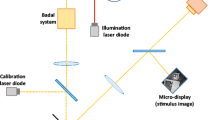Abstract
A general mechanism is studied which adapts the value of some biological parameter so as to maximize or to minimize the value of another parameter. In the process of visual accommodation, the thickness of the lens is determined by the maximum sharpness of the image on the retina. A neural mechanism which provides for such an optimum adjustment is described. A similar mechanism may play a role in such phenomena as hedonistic behavior where activity is adjusted to a maximum of satisfaction. The mechanism discussed here does not provide for an absolutely sharp retinal image, but leads to a conclusion that the sharpness of that image fluctuates within narrow limits which are determined by the parameters of the systems.
Similar content being viewed by others
Literature
Rashevsky, N. 1948.Mathematical Biophysics. Rev. Ed. Chicago: The University of Chicago Press.
—. 1951.Mathematical Biology of Social Behavior. Chicago: The University of Chicago Press.
Author information
Authors and Affiliations
Rights and permissions
About this article
Cite this article
Rashevsky, N. A neural mechanism for adjustment to optimal conditions, with possible reference to visual accommodation. Bulletin of Mathematical Biophysics 18, 189–198 (1956). https://doi.org/10.1007/BF02481854
Received:
Issue Date:
DOI: https://doi.org/10.1007/BF02481854




